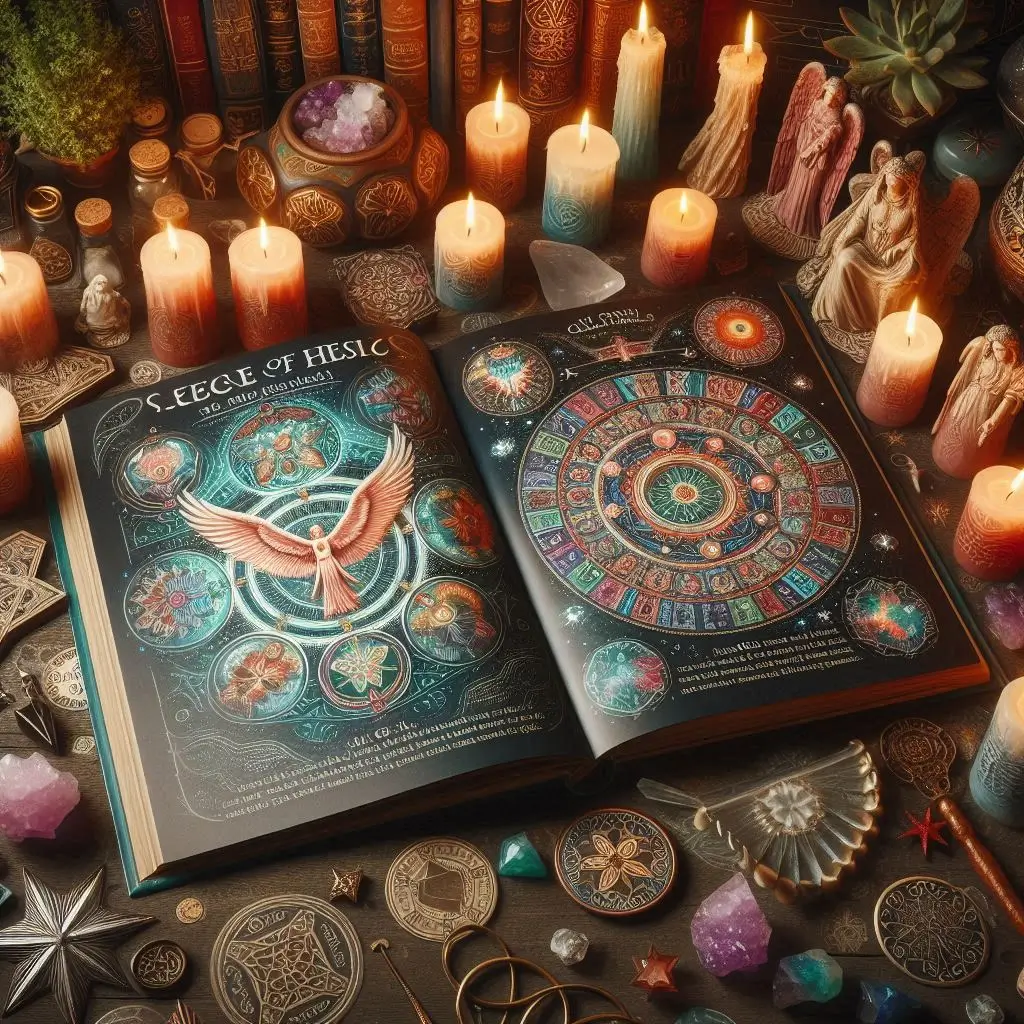Angel numbers may seem like a modern spiritual phenomenon, but the sacred significance of numerical patterns has deep roots in human history, spanning cultures, religions, and even scientific understanding.


This comprehensive exploration delves into both the historical foundations and contemporary scientific perspectives on the mysterious numerical sequences that many experience as divine guidance.
Whether you’re a skeptical researcher seeking context, a spiritual seeker wanting historical grounding, or simply curious about the intersection of science and spirituality, this deep dive offers a nuanced understanding of angel numbers beyond basic interpretations.
“The language of numbers transcends time and cultural boundaries—what we now call ‘angel numbers’ represents our modern encounter with a sacred mathematical code that humans have been interpreting for millennia.”
Part I: The Historical Foundations of Angel Numbers
Ancient Numerical Divination Systems
The practice of deriving spiritual meaning from numbers dates back to some of humanity’s earliest civilizations:
Mesopotamian Numerical Divination (c. 3000 BCE)
The Sumerians and Babylonians developed sophisticated systems of numerical interpretation, believing that gods communicated through mathematical patterns.
Their sexagesimal system (base 60) remains with us today in our measurements of time and angular degrees.
Key Concept: Gematria-Proto – Early Babylonian priests assigned numerical values to divine names, creating sacred numbers that were watched for in daily life as signs of divine presence or intervention.
Egyptian Sacred Mathematics (c. 3000 BCE)
Ancient Egyptians viewed numbers as divine tools for creating cosmic order.
Their understanding of sacred geometry and mathematical proportions influenced their architecture, religious practices, and understanding of the afterlife.
Key Numbers:
- 3 – Represented the triad of Osiris, Isis, and Horus
- 4 – Symbolized completeness and solidity (four cardinal directions)
- 7 – Represented perfection and effectiveness
- 8 – Associated with cosmic balance and regeneration
Chinese Numerology (I Ching, c. 1000 BCE)
The I Ching (Book of Changes) represents one of the world’s oldest numerical divination systems.
Based on binary mathematics, it uses combinations of broken and unbroken lines to create 64 hexagrams, each with unique divinatory meanings.
Key Concept: Li (理) – The underlying principle of meaningful pattern and order in the universe, expressed through numerical relationships that could be interpreted for guidance.
Sacred Number Systems in Classical Antiquity
Pythagorean Numerology (6th century BCE)
The Greek philosopher Pythagoras and his followers developed perhaps the most influential system of numerical mysticism in Western history.


They believed that numbers were the fundamental elements of all things and that mathematical relationships revealed cosmic truths.
Pythagorean Principles That Influence Modern Angel Number Interpretation:
- Numbers Have Qualitative Properties – Each number possesses unique metaphysical qualities and spiritual vibrations
- Mathematical Harmony Reflects Cosmic Order – The mathematical relationships observable in music, astronomy, and geometry reveal divine design
- Numbers as Archetypes – Single digits (1-9) represent fundamental archetypal energies from which all other numbers derive meaning
- Reduction Method – The practice of reducing multi-digit numbers to a single digit (e.g., 254 = 2+5+4 = 11 = 1+1 = 2) to reveal core essence
Pythagoras on Repeating Numbers: While not specifically addressing what we now call “angel numbers,” Pythagorean teachings held that repeated numerical patterns carried amplified significance and represented cosmic emphasis—a principle that directly informs modern angel number interpretation.
Roman Numerological Practices
The Romans adopted and modified Greek numerological concepts, integrating them into divination practices, architecture, and administrative systems.
Notable Roman Contribution: The practice of calculating “lucky numbers” for individuals based on birth circumstances and watching for their appearance as favorable omens—a precursor to the personalized aspect of modern angel number interpretation.
Sacred Numbers in World Religions
Judaism and Kabbalah (from c. 500 BCE)
Hebrew mysticism developed sophisticated systems for interpreting the numerical values of letters and words, believing divine wisdom was encoded in these mathematical relationships.
Key Concepts:
- Gematria – The system of assigning numerical values to Hebrew letters, allowing texts (particularly Torah) to be interpreted through mathematical relationships
- Sephirot – The 10 emanations of God in Kabbalistic tradition, representing a numerical framework for understanding divine attributes
Example: The Hebrew word for life (חי) has a numerical value of 18, making 18 a particularly auspicious number in Jewish tradition—appearing on jewelry and in monetary gifts.
Christianity and Angelic Numbers (1st century CE onward)
Early Christian numerology was heavily influenced by both Jewish traditions and Pythagorean concepts, with numbers in biblical texts assigned profound symbolic significance.
Key Biblical Numerical Patterns:
- 3 – Divine perfection (Trinity)
- 7 – Divine completion or perfection (7 days of creation)
- 12 – Divine governance (12 tribes, 12 apostles)
- 40 – Period of testing or trial (40 days of flood, 40 years in wilderness, 40 days of Jesus’s temptation)
Angelic Associations: The term “angel numbers” connects to the Christian tradition of angels as messengers (the word “angel” derives from the Greek “angelos” meaning messenger).
The concept of angels using numbers as communication appears in various medieval Christian mystical texts.
St. Augustine (354-430 CE) wrote extensively on the spiritual significance of numbers in scripture, arguing that mathematical patterns revealed divine intention rather than coincidence.
Islamic Abjad and Numerology (7th century CE onward)
Islamic traditions developed sophisticated numerical interpretation systems, with particular emphasis on the numerical values of the names of Allah and verses of the Quran.
Key Concept: ‘Ilm al-Huruf – The “science of letters” that explored the numerical values and spiritual significance of Arabic letters and their sequences in sacred texts.
The mystical branch of Sufism particularly developed practices of contemplating numerical patterns as pathways to divine understanding.
Hindu Vedic Numerology (ancient origins, systematized c. 500 CE)


Hindu traditions contain some of the most mathematically sophisticated numerical divination systems, intricately connected to astronomical cycles and cosmic time.
Key Concept: Anka Shastra – The science of numbers that assigns planetary rulerships and spiritual qualities to each number, with particular emphasis on birth date analysis.
Vedic mathematics recognized the special properties of repeating digits, considering them to hold concentrated energetic properties—a concept strikingly similar to contemporary angel number interpretations.
Historical Bridge to Modern Angel Numbers
Theosophical Influence (late 19th-early 20th century)
The Theosophical Society, founded in 1875 by Helena Blavatsky, played a crucial role in synthesizing Eastern and Western esoteric traditions, including numerical mysticism.
Prominent Theosophist Annie Besant wrote extensively on the “hidden significance of numbers,” proposing that repeated number sequences represented communications from higher planes of consciousness.
New Thought Movement (early 20th century)
New Thought writers like Florence Scovel Shinn and Catherine Ponder popularized the idea that numbers carried vibrational messages and could be interpreted for personal guidance—laying groundwork for the contemporary understanding of angel numbers.
Doreen Virtue and Modern Codification (1990s-2000s)
While numerical mysticism has ancient roots, the specific term “angel numbers” and the systematized interpretation of repeating digits (111, 222, 333, etc.) gained widespread popularity largely through the works of author Doreen Virtue in the late 1990s and early 2000s.
Virtue synthesized elements from various traditions into an accessible system focused specifically on repeating numerical sequences as angelic communications, effectively creating the modern angel number paradigm that continues to evolve today.
Part II: Scientific Perspectives on Angel Number Experiences
While traditional science doesn’t validate angel numbers as divine communications, several scientific frameworks offer interesting perspectives on why people experience these numerical patterns as meaningful:
Cognitive Science: Pattern Recognition and Meaning-Making
Apophenia and Pareidolia
The human brain is fundamentally a pattern-recognition system—neurologically wired to detect patterns and assign meaning to them.
This adaptive trait helped our ancestors identify both threats and opportunities in the environment.
Key Concept: Apophenia – The tendency to perceive meaningful connections between unrelated phenomena, with pareidolia being the specific form related to visual or sensory patterns.
Research Insight: Cognitive neuroscientist Michael Shermer describes what he calls “patternicity”—the evolved tendency to find meaningful patterns in both meaningful and meaningless data, arguing it was evolutionarily advantageous to occasionally detect false patterns than to miss real ones.
Confirmation Bias and Selective Attention
Once someone becomes aware of a particular number sequence (like 111 or 444), cognitive processes tend to prioritize those patterns in attention and memory.


Research Insight: Studies show that when people are primed to notice specific patterns, their cognitive filtering systems highlight those patterns while potentially filtering out others.
This helps explain why once someone begins noticing angel numbers, they often report seeing them with increasing frequency.
Scientific Perspective: From a strictly materialist scientific viewpoint, angel numbers represent the combination of random numerical distributions in the environment filtered through selective perception and confirmation bias—we notice the “hits” (when we see significant numbers) and forget the “misses” (all the other numbers we encounter).
Neuroscience: The Brain’s Response to Numerical Synchronicities
The Dopamine Connection
The experience of noticing meaningful number patterns typically triggers dopamine release in the brain’s reward circuitry, creating positive emotional associations.
Research Insight: Neuroscientists at the University of Pennsylvania found that recognizing patterns activates the brain’s reward centers, explaining why spotting angel numbers often creates positive emotional responses.
Default Mode Network Activity
Research into the brain’s default mode network (DMN)—active during self-referential thinking and meaning-making—shows heightened activity when people encounter experiences they interpret as spiritually significant.
Scientific Perspective: Neurologically, angel number experiences may represent the intersection of pattern recognition, reward circuitry activation, and meaning-making networks in the brain creating a subjectively meaningful experience, regardless of whether external forces are actually communicating.
Statistical Mathematics: The Reality of Numerical Clustering
Randomness Creates Clusters
Counterintuitively, truly random distributions naturally create clusters and patterns rather than perfectly even distribution—a mathematical reality known as the clustering illusion.
Research Insight: Mathematician Lisa Goldberg demonstrated that in random sequences, repeating patterns appear with predictable frequency.
What seems like an improbable numerical “coincidence” is often mathematically expected in large number sets.
Benford’s Law and Natural Number Distribution
Certain numerical patterns appear with predictable frequency in natural and human systems.
Benford’s Law, for example, describes how in many naturally occurring collections of numbers, the leading digit is likely to be small (1 appears as the first digit about 30% of the time).
Scientific Perspective: Mathematical analysis suggests that some numerical patterns we experience as meaningful may reflect underlying mathematical properties of natural systems rather than random coincidence or supernatural communication.
Quantum Physics: A Bridge Between Science and Spiritual Interpretation?
Non-locality and Entanglement
Quantum physics has demonstrated that separated particles can remain “entangled,” with changes to one instantaneously affecting the other regardless of distance—suggesting deeper connections in reality than classical physics recognized.
Theoretical Connection: Some theorists propose that meaningful synchronicities (including numerical ones) might represent macroscopic manifestations of quantum non-locality—moments when the typically hidden interconnected nature of reality becomes briefly perceptible.
Observer Effect and Consciousness
Quantum experiments have repeatedly shown that the act of observation affects quantum outcomes, placing consciousness in an unusual position compared to classical physics.
Theoretical Perspective: Physicist John Wheeler’s “participatory universe” concept suggests that consciousness and reality are fundamentally intertwined.
Applied to angel numbers, this perspective suggests the possibility that the meaning perceived in numerical patterns isn’t merely subjectively imposed but emerges from the interaction between consciousness and information fields.
Psychology: Why Angel Numbers Feel Meaningful
Carl Jung’s Synchronicity Principle
Carl Jung, founder of analytical psychology, developed the concept of “synchronicity” to describe “meaningful coincidences” that appear acausally connected.
Jung believed these experiences revealed underlying patterns in the collective unconscious.


Key Insight: Jung documented numerous cases where numerical coincidences corresponded meaningfully with a person’s psychological state, arguing these represented more than mere chance or cognitive bias.
Transpersonal Psychology Perspectives
The field of transpersonal psychology examines experiences that seem to connect individual consciousness with broader dimensions of existence.
Research Insight: Studies by the Institute of Noetic Sciences have documented thousands of cases where people report meaningful numerical synchronicities in connection with significant life events, suggesting these experiences represent a common aspect of human consciousness rather than isolated anomalies.
Anthropology: Cross-Cultural Numerical Synchronicity Experiences
Anthropological research reveals that experiences of meaningful numerical patterns occur across widely divergent cultures, suggesting a universal human experience rather than merely culturally constructed phenomenon.
Research Insight: Anthropologist Susan Greenwood documented remarkably similar experiences of numerical synchronicity across cultures with no historical contact, with subjects consistently reporting feelings of:
- Being “noticed” by a greater intelligence
- Receiving confirmation of being on the right path
- Experiencing a momentary transcendence of ordinary causality
Scientific Perspective: The cross-cultural universality of numerical synchronicity experiences suggests they may represent an inherent feature of human consciousness rather than merely culturally transmitted beliefs.
Part III: Integrating Historical Wisdom and Scientific Understanding
Beyond the False Dichotomy
The history and science of angel numbers reveals that the simplistic dichotomy of “real spiritual phenomenon vs. cognitive illusion” fails to capture the rich complexity of these experiences.
A more nuanced perspective recognizes that:
- Angel numbers emerge from authentic historical traditions of numerical interpretation spanning diverse cultures and millennia
- Well-established cognitive mechanisms explain how and why we notice these patterns
- The subjective impact and meaning of these experiences remains significant regardless of their ontological status
The Consciousness-Reality Interface Model
A integrative framework for understanding angel numbers might be what philosopher David Chalmers calls the “consciousness-reality interface” perspective:
Key Concept: Our experience of reality always occurs at the interface between consciousness and information.
Angel numbers may represent moments when patterns in the information field interact with consciousness in ways that generate meaningful experiences.
This model allows for both:
- Scientific understanding of the cognitive, neurological, and statistical factors involved
- Openness to the possibility that these patterns reflect deeper ordering principles in reality that consciousness can access
Practical Integration for the Modern Seeker
How might someone interested in angel numbers approach them with both historical perspective and scientific understanding?
1. Acknowledge Multiple Levels of Analysis
Recognize that angel numbers can be simultaneously understood through:
- Historical/traditional frameworks of divine communication
- Psychological frameworks of meaningful pattern recognition
- Neurological frameworks of brain function and pattern detection
- Statistical frameworks of probability and randomness
No single framework provides complete understanding, and they need not be mutually exclusive.
2. Practice “Epistemological Humility”


Both dogmatic skepticism and unquestioning belief close off avenues of understanding.
An approach of “epistemological humility” remains open to multiple possibilities:
- These patterns might represent random coincidences given meaning by human psychology
- They might reflect subtle ordering principles in reality that consciousness can detect
- They might represent communications from non-physical intelligences or dimensions
- They might be all or none of the above in ways our current understanding cannot fully capture
3. Focus on Pragmatic Value
Whether angel numbers represent external communication or internal meaning-making, their practical value lies in:
- Prompting moments of mindfulness and reflection
- Creating opportunities for intuitive insight
- Offering symbolic frameworks for processing life experiences
- Providing decision-making guidance through accessing non-analytical knowing
4. Engage in Personal Empiricism
The most balanced approach involves personal empiricism—systematically exploring your own experience while remaining open to multiple interpretations:
Try This Historical-Scientific Journaling Practice:
- Record angel numbers that appear in your experience
- Note historical interpretations from various traditions
- Acknowledge the cognitive and statistical factors possibly involved
- Document the practical insights or guidance received
- Track the outcomes of decisions made with this guidance
- Over time, assess the patterns and value that emerge from your personal data
Part IV: Beyond Interpretation: The Deeper Significance of Numerical Patterns
Mathematical Universe Hypothesis
Physicist Max Tegmark proposes that the universe is fundamentally mathematical in nature—not just described by mathematics but actually made of mathematical structures.
Philosophical Implication: If reality is fundamentally mathematical, our recognition of meaningful numerical patterns might represent moments of direct perception of reality’s underlying structure rather than merely subjective interpretation.
Information Theory and Meaningful Patterns
Information theory examines how patterns can be distinguished from random noise, with meaningful patterns containing what mathematician Claude Shannon called “negentropy” (negative entropy or organization).
Key Insight: Angel numbers might represent moments when consciousness detects meaningful information compression in seemingly random numerical environments—patterns that contain more information than would be expected by chance.
The Anthropic Principle and Fine-Tuning
The anthropic principle observes that the fundamental constants of the universe appear “fine-tuned” to precise mathematical values that allow for the existence of life.
Philosophical Connection: The precise numerical values that govern cosmic forces suggest the universe itself might be understood as a vast numerical pattern with embedded meaning—a perspective that contextualizes the human experience of meaningful numerical sequences within a mathematically structured cosmos.
The Continuing Dialogue Between Science and Spirit
The phenomenon of angel numbers represents a fascinating case study in the ongoing dialogue between scientific and spiritual understanding.
Rather than representing opposing worldviews, the historical depth and scientific perspectives on angel numbers reveal complementary approaches to a complex human experience.
For the contemporary person navigating these waters, the richest understanding comes not from choosing between historical wisdom and scientific insight, but from allowing both to inform a nuanced, multi-dimensional perspective on the remarkable human capacity to find meaning in mathematical patterns.
Whether angel numbers represent divine communication, psychological meaning-making, quantum information fields, or some combination beyond our current understanding, they continue to offer moments of wonder and connection in a universe whose deepest nature may indeed be mathematical.
As mathematician Paul Erdős often said when encountering particularly elegant mathematical proofs: “This one is from The Book”—referring to an imaginary book in which God had written the most beautiful mathematical proofs.
Perhaps when we encounter angel numbers, we are glimpsing, however briefly, a page from that cosmic mathematical book.

